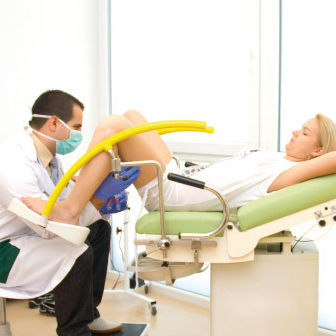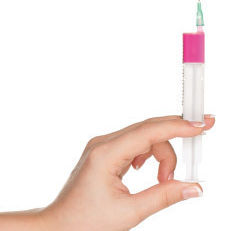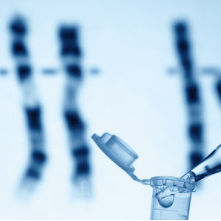The Waiting Game

For patients of Paula Amato, there are no gray areas, no charts with lines that curve up or down to indicate improvement or decline. There’s only positive or negative—one or the other.
“In other areas of medicine, there can be incremental progress,” Dr. Amato says. “But pregnancy is black and white. You either are, or you’re not.” For women working with Dr. Amato and other ob-gyns at the Oregon Health & Science University Fertility Center, though, the experience adds up to much more than a simple either-or.
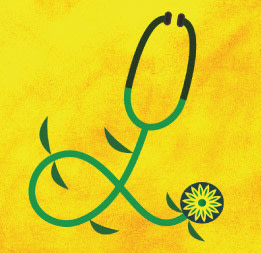
A Doctor
“Typically when I see patients, they’ve already been trying for years,” says Dr. Amato, a subspecialist in reproductive endocrinology and infertility. “I empathize with them. I want it to work. But the overall pregnancy success rate is still around 50 percent per cycle, so half the time I’m the bearer of bad news.”
Dr. Amato believes that for her patients, knowing that rate of success is crucial to making an informed decision.
“Infertility is emotionally charged and physically taxing for most patients,” she says. “And we can never guarantee success.”
New advances in infertility care—“infertility” is defined by the Centers for Disease Control and Prevention (CDC) as no pregnancy after one year of trying—encourage Dr. Amato and her team. Part of the OHSU Center for Women’s Health, their clinic addresses reproductive health from evaluation and treatment to egg donation, fertility preservation, and preimplantation genetic diagnosis. Nationwide, success rates are up for assisted reproductive technologies like in vitro fertilization (IVF) and intracytoplasmic sperm injection (ICSI). Technical improvements have allowed for transfer of fewer embryos. Egg donation is on the rise, as is interest in egg
preservation.
“Awareness of the decline in fertility that occurs with age is growing,” Dr. Amato says. “But I still see women surprised—they may feel young, exercise, and eat well, but their eggs may be acting older than they otherwise feel.”
As the demographics of modern parenthood evolve, new techniques compete with this truth. While fertility declines with age for both men and women—though much less so for men—women’s fertility drops sharply after age 37. Of the 20 percent of women in the United States now having their first child after the age of 35, the CDC estimates one-third will experience infertility.
During an initial consultation, Dr. Amato will review a new patient’s full medical history and may perform testing before arriving at a treatment recommendation. She tends to start with the least invasive and lowest-cost therapies. Ovulation-induction medications like clomiphene citrate, in combination with intrauterine insemination, are often prescribed for three to six cycles.
At the other end of the spectrum is IVF, the most successful fertility therapy, but also the most invasive and costly.
“IVF doesn’t happen without a team,” says Dr. Amato. Working closely with the clinic’s other physicians (Drs. Lee, Patton, and Wu), nurses, laboratory embryologists, and often other medical specialists—including urologists, perinatalogists, and mental health counselors—Dr. Amato
and her team provide 24/7 care to coordinate the complex interplay of ovarian-stimulating medications, ultrasound and hormone monitoring, egg retrieval, and embryo transfer.
Given the OHSU Fertility Center’s reputation for quality medical care and a supportive, patient-centered environment, Dr. Amato concedes frustration that in Oregon, few insurance plans cover infertility treatments like IVF. From expanding insurance coverage for fertility services to pioneering new research, she sees room for improvement. But, she cautions, there will never be a guarantee, which can be difficult for patients as well as their care providers.
“As a physician, it’s difficult not to feel personally responsible for the outcome, despite the many factors that are out of our control,” she says. “I share in the miracle, but I also share in the disappointment.”
A Miracle
Two black labs are barking in the Salem house that Zoe Ann Jundt, 31, shares with her husband, Chris.
“They are our kids for the time being,” says Zoe, who works in customer service for First American Title.
When Zoe and Chris first started trying to conceive in August 2009, they were newly married and eager to start a family. After one year of no pregnancy, Zoe got tested. Her ob-gyn in Salem prescribed Clomid, a brand name for clomiphene citrate.
“I was on Clomid for six months before we tested my husband,” Zoe says. “I was convinced that it was me, and was shocked that it wasn’t.”
Over the next year, Zoe and Chris each tried sequential rounds of taking Clomid and then tried taking it simultaneously, but Chris’s sperm levels didn’t rise. Zoe’s ob-gyn proposed intrauterine insemination, as well as a shot of the hormone hCG to trigger ovulation. Nothing worked.
That’s when Zoe’s sister-in-law, newly pregnant, suggested her doctors at the OHSU Fertility Center. “With her recommendation,” Zoe says,
Following an initial consultation with Dr. Amato in January 2012, Zoe and Chris realized that IVF was their best option.
“It was ... well, easy isn’t the right word,” Zoe says. “At the clinic, you get poked a lot. It’s a lot to go through for your poor body, but it’s for a greater good. From the beginning they took such good care of me. They kept me in the know.”
Soon after her January consultation, Zoe took birth control pills to help optimize follicle growth for later egg recovery. A few weeks later, in February, she began shots for ovarian stimulation. Following a week of injections, she returned to the clinic every few days for ultrasound monitoring and hormone measurements.
During Zoe’s egg retrieval process, 12 eggs were retrieved and 9 successfully fertilized in vitro by clinic specialists. Of the four fertilized embryos that proved viable, two were frozen and two were transferred into her uterus. On March 17, Zoe began a nearly two-week wait before blood work could conclusively determine the outcome.
“When we knew in vitro is what we had to do, I didn’t think I could do it,” Zoe says. “I was afraid of the egg retrieval process, of the emotions involved. Now, I’d tell people not to be afraid—the process was not as bad as I thought.”
On March 27, Zoe’s pregnancy test came back positive. Following an ultrasound, the results were confirmed: a single pregnancy, due November 3.
“It’s a miracle,” Zoe says. “Now that it’s here, it’s hard to remember the process. It was all worth it.”
After three years of infertility, Zoe and Chris are celebrating, but quietly.
“I don’t share it with everybody. Not everyone who knows I’m pregnant knows that it was IVF,” she says. “You don’t know how they’ll take it. And though I was successful the first time with in vitro, I know a lot of women aren’t.”

A Journey
From Medford, Crystal Pump, 29, has centered her life on children. A fourth-grade schoolteacher in nearby Rogue River, Crystal married her husband, Michael, a school psychologist, in 2008. With plans for a big family, the couple immediately started trying to conceive.
“We felt that we’d be one of those couples that calls everyone within a month with the news [that we were expecting],” Crystal says. “But the further we got from our wedding, the more heartsick we got. My husband’s older than I am. I felt that I couldn’t wait.”
Crystal and Michael consulted a doctor in Medford, who suggested intrauterine insemination and Clomid. After four costly attempts, their ob-gyn pointed them to the OHSU Fertility Center. Their first consultation took place in fall despite the onslaught of procedures, Crystal describes the clinic atmosphere as “phenomenal.”

“One thing that really attracted me to OHSU was that the people at the front desk were as helpful and friendly as the doctors and nurses,” she says. “I felt that everyone was in my corner.”
Crystal’s first IVF treatment did not result in a pregnancy, so Dr. Amato tweaked the medication protocol, and the couple tried again.
“We thought, now my body would know what to do,” Crystal says.
After a second round of IVF, clinic staff tested Crystal’s blood for pregnancy hormone levels.
“My number was seven,” Crystal says. “Technically that’s pregnant, but still very low. If it’s healthy, my number should double.”
Instead, her number dropped—suggesting an early miscarriage sometimes called a “biochemical pregnancy.” Still hopeful, the couple took time to save up for one more round of IVF. Crystal and Michael returned to the clinic in January 2012, but like their previous two experiences, their third attempt at IVF did not result in pregnancy.
“The hard part, the part that people might not get, is the hope—what I call the hope-a-coaster,” Crystal says. “You feel you have every sign of pregnancy, and then the negative. It’s a feeling of getting slapped down.”
Crystal says that one way or another, she and Michael know they will be parents. Right now, they’re stepping back to relax, reflect, and evaluate next steps.
“I’ve gone through this to share our story with others,” she says. “Infertility’s not something like getting your arm cut off. It’s internal, and so hard to find other people to relate to. But once we started talking to people, it became more common than we had thought.”
Crystal concedes that the process of IVF was emotionally challenging—“the hardest journey I’ve ever taken.” Though IVF did not result in a pregnancy for her and Michael, Crystal says the bond they developed with their clinic doctors—in addition to Dr. Amato, they worked with Drs. David Lee and Phillip Patton—was phenomenal.
“I wouldn’t take back this experience, having met such fabulous people, having them become a part of our lives,” she says. “I’m a firm believer that everything happens for a reason.
“If I could say one thing, it would be to have hope. We know there’s a journey for us to be parents.”
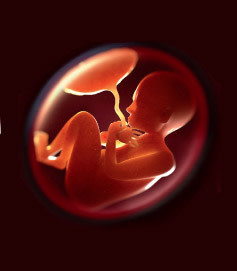
Beyond IVF
Mitochondrial DNA Replacement

